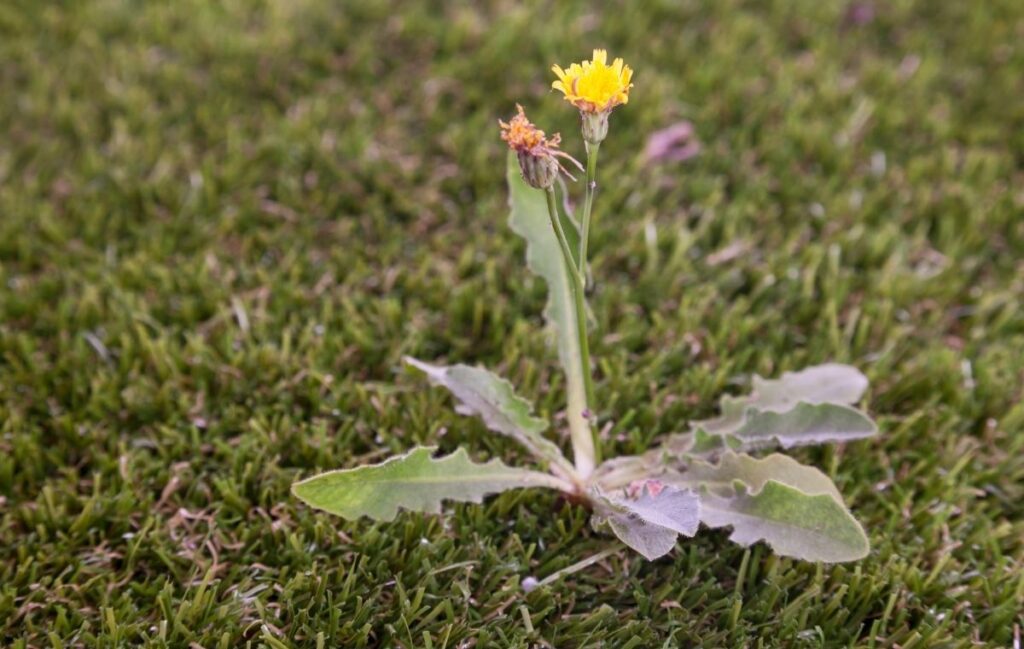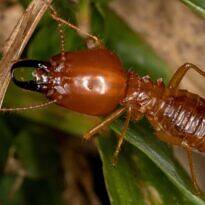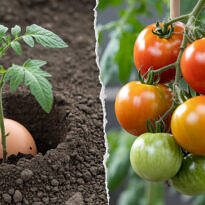If you have a garden or work with gardening, you’ve probably been troubled by weeds, right?
Controlling weeds in ornamental lawns is an ongoing challenge, especially in tropical areas like Australia or in Florida, where diverse climate and rich plant species can create ideal conditions for a variety of unwanted herbs to thrive. In this context, it’s crucial to understand that effective weed control isn’t just about eliminating the weeds, but also involves maintaining the health and aesthetics of the lawn. Weeds can compete with the grass for nutrients, water, and light, and can host pests and diseases, compromising the quality of the lawn. But before we proceed, let’s reflect on what weeds are, and why we desire a uniform lawn.
Should the Lawn Be a Monoculture?
If you think about it, the garden lawn is, just like a corn or soy plantation, a monoculture. As such, it lacks diversity, a diversity that protects against large infestations of pests and diseases, and although seemingly chaotic, is in perfect natural balance. The uniform lawn as we know it is thus a monoculture, and as such, is imbalanced and requires intensive care, just like the mentioned crops.
Historically, the concept of the lawn as a monoculture of a single grass species, appearing unblemished, has its roots in 18th-century Europe, especially in England. This idea was strongly influenced by a landscape aesthetic that valued order and symmetry, symbolizing status and man’s control over nature. Over time, this view spread to other parts of the world, where monocultural lawns became symbols of beauty and care in homes, parks, and public spaces.
But we must understand that maintaining a lawn as a monoculture presents several ecological disadvantages. Firstly, the lack of biological diversity can lead to increased vulnerability to pests and diseases, requiring more intensive use of pesticides and herbicides, which can have negative impacts on the environment and even our health. Furthermore, uniform lawns typically require more resources, such as water and fertilizers, to maintain their aesthetically pleasing appearance.
Therefore, recently, there has been a growing movement in favor of more diversified lawns, including the sporadic growth of herbs and flowers (and even the intentional planting of them!). This approach not only reduces the need for intensive maintenance but also offers significant ecological benefits. For instance, including native flowers in a lawn can provide a vital habitat for pollinators like bees and butterflies, contributing to local biodiversity. It is important to reflect and discuss these possibilities with your client so that we can make more conscious choices when managing lawns.
What is a Weed?
The notion of “weed” is inherently relative and varies according to cultural, ecological, and agronomic contexts. Traditionally, a weed is defined as any plant that grows where it is not wanted. However, this definition is largely subjective and based on human perceptions of utility and aesthetics, rather than botanical characteristics. The plant is not naturally “evil”; we put it in that box because we are bothered by its presence.
Thus, what is considered a weed in one context might be seen as a valuable plant in another. For example, some plants commonly labeled as weeds in lawns, such as the dandelion (Taraxacum officinale), are appreciated in other cultures for their medicinal properties or as food. Additionally, in natural ecosystems, many of these plants play important ecological roles, like providing food for pollinators or aiding in soil regeneration.
In lawn management, the perspective on what constitutes a weed can significantly influence gardening practices. While some professionals and garden owners may strive to eliminate all different plants, others may adopt a more tolerant approach, allowing certain species due to their ecological or aesthetic benefits. This tolerance can reduce the need for chemical interventions and contribute to garden sustainability.

Understanding weeds as a relative concept allows for a more flexible and conscious approach in lawn and garden management. Instead of rigidly adhering to the idea of eliminating all weeds, it’s possible to adopt a more holistic view, considering the ecological benefits and beauty that these plants can bring. This perspective is especially relevant in tropical areas where rich biodiversity offers unique opportunities for the harmonious integration of various plant species in gardens.
Adopting a more diversified lawn requires a change in the cultural perception of beauty in landscaping. This paradigm shift is not only ecologically beneficial but can also lead to a new appreciation for the variety and beauty found in nature. Discovering a little flower here and there can add interest and surprise to the garden, save a good deal of money on pesticides and heavy labor, and promote a healthier and more resilient ecosystem.
With this perspective, we can explore various weed control techniques, from mechanical methods to chemical and organic solutions, always aiming to maintain the health and beauty of lawns, according to the client’s wishes, but more aware and respectful of the rich biodiversity that surrounds us.
Identification of Weeds
Correct identification of weeds is the crucial first step in effective management in ornamental lawns. But before your brain gets tied in knots, thinking that you will need to memorize plant names, consider that identifying the type of weed is more efficient than memorizing complicated botanical names, especially when needing to resort to herbicides for control. Correctly classifying the infesting plants will make the chosen method more assertive (and economical), avoiding rework.
However, it is worth knowing and studying the main weeds that affect lawns in your region. Take your time, and as you gain experience. It’s useless to study books (or websites!) that bring generalized information, which do not contemplate local plants. Knowing each of the different species, their life cycle, their resistance, and susceptibility to control methods will make all the difference when it comes to controlling them.
Also, often correctly identifying the species can bring us information about soil conditions. Some species prefer acidic soils, for example, and a simple pH correction can make the environment unfavorable for their development. Similarly, other species prefer poorly drained, swampy, shaded soils, etc. Instead of attacking just the consequence, the informed gardener will also be able to attack the cause of the problem, preventing it from reappearing.
For a good knowledge base, we can classify weeds into two main groups: monocots and dicots. The distinction between monocots and dicots is fundamental for efficient weed management, as it directly influences the choice of herbicide. Some herbicides are effective against one group but not the other, or may even harm the lawn if applied incorrectly. Furthermore, this classification aids in understanding the life cycle and growth characteristics of weeds, essential for effective control.
Monocots
- Characteristics: Generally have narrow and long leaves, with parallel veins. The most important example is the grass itself! Understanding that grasses are monocots helps us realize that we should be careful with herbicides that affect these plants.
- Common Examples:
- Cyperus rotundus (Nutgrass): with thin, pointed leaves.
- Eleusine indica (Goosegrass): common in compacted soils.
- Importance in Choosing Herbicides: The herbicides available for amateur gardening are not specifically selective for monocots, presenting a challenge for gardeners and landscapers.
Dicots
- Characteristics: Typically have broader leaves with branched veins. Many weeds with showy flowers belong to this group.
- Common Examples:
- Bidens pilosa (Blackjack): known for its small yellow flowers and seeds that stick to clothing.
- Taraxacum officinale (Dandelion): is a classic example of a dicot weed.
- Importance in Choosing Herbicides: Herbicides selective for dicots are designed to attack these plants without damaging monocots. They are effective against a variety of common broadleaf weeds in lawns.
Physical Control
Physical or mechanical weed control is an important strategy where the use of chemicals can be restricted or undesirable. This method is ideal for situations where environmental preservation and safety are priorities, such as in residential areas, schools, and parks. Moreover, physical control is essential in lawns where weeds are resistant to herbicides or when an immediate solution is sought without the waiting period that accompanies chemical applications.
Manual Weeding and Use of Tools

Manual weeding is the most direct way to remove weeds. Tools like hoes, firminos, gardening knives, and weed pullers are effective for this purpose. The process involves removing each weed one by one, including their roots, to prevent regrowth. However, this approach can be laborious and time-consuming, especially in large areas. Manual weeding is most effective when weeds are young and the soil is moist, facilitating complete root removal. Some weeds, like nutgrass, develop deep bulbs and break their stems before it’s possible to access them through pulling, reducing the effectiveness of manual weeding.
Cutting or Mowing
A highly effective technique in weed management is regular cutting or mowing. Mowing the grass not only keeps the lawn looking uniform and aesthetically pleasing but also plays a crucial role in weed control. By mowing the grass regularly, you reduce competition for light, nutrients, and water between the grass and weeds. Frequent mowing prevents weeds from reaching their flowering and seed dispersal stage, a critical phase for their propagation.
Furthermore, the cutting height is a key factor in efficient weed management. Cutting too low can damage the grass and expose the soil, creating ideal conditions for the emergence and growth of weeds. On the other hand, cutting at the appropriate height, typically between 1 and 3 inches, depending on the grass species, helps create a dense canopy that limits the sunlight reaching the soil, suppressing the growth of unwanted weeds. The cutting technique should be carried out with proper equipment, such as lawn mowers with height adjustment, leaving the trimmer for finishing in hard-to-reach areas.
Solarization and Blocking Photosynthesis
Solarization is an efficient method of physical control, especially in hot, sunny climates, and for recovering infested areas where you intend to replant the lawn without using herbicides. It involves covering the soil with black plastic, which raises soil temperatures to levels that can destroy weeds, seeds, and even pathogens like nematodes and bugs. The plastic should be kept for 4 to 6 weeks during the hottest period of the year. This method also blocks the plants’ access to sunlight while heating them up, forcing them to use their reserves and weakening their potential to regrow. This method is effective but requires planning and is not feasible for large areas.
Flame Weeding
Flame weeding, or a weed burner, is a tool that uses the heat of flames to kill weeds. The heat dehydrates and carbonizes the plant cells, causing them to die. It’s a quick option for small areas but requires care to avoid damage to the lawn and fire hazards. Flame weeding is great for areas with stone pavements, pavers, or cement. Keep the flame moving to not focus too long on a single area and avoid using on windy days or in dry conditions. Ideally, use torches with appropriate nozzles and lightweight, ergonomic options for carrying the fuel.
In summary, physical weed control is a safe and environmentally friendly approach, suitable for various situations. Although it may be more labor-intensive than chemical methods, it offers significant benefits in terms of safety and sustainability.
Chemical Control
In the world of gardening, the issue of herbicides is surrounded by a paradoxical intrigue. On the one hand, we have an impressive array of technologies and chemical formulations, each promising to be the definitive solution for weed control. However, in the practical reality of gardening, only a handful of these products are actually available and authorized for use in gardens. This scenario raises a fascinating question:
Why do we have a limited arsenal for gardeners and landscapers?
At first glance, this restriction may seem like a major obstacle. With so many weed species, each with their own growth peculiarities and resistance, the idea of having only a few herbicide options might seem limiting. However, there’s a silver lining to this story. The careful selection and strict regulation of herbicides for gardening reflect a growing concern for environmental health and public safety. These restrictions ensure that only products with a proven profile of efficacy and safety are used in our gardens and green spaces. After all, these spaces are frequented by people, pets, and often children, who think twice before putting a blade of grass in their mouths.
Faced with a more restricted range of chemical options, gardeners and agronomists are challenged to explore alternative methods of weed control, such as cultural, mechanical, and even biological practices. Whether we like it or not, this is an opportunity to re-examine and reassess traditional practices, adapting them to local needs and conditions.
Have you ever wondered why, despite the availability of many methods, chemical control remains one of the most effective in combating weeds in lawns? The answer lies in its ability to directly target unwanted weeds, drastically reducing their presence. But how do you choose the right herbicide and apply it effectively and safely? Let’s explore two common herbicides (approved for gardening): glyphosate and imazapir.
Glyphosate: The Universal Known
Glyphosate, a household name in herbicides and often known by trade names like Matamato, Roundup, Terminat, etc., is recognized for its effectiveness in eradicating a wide range of weeds. Its effectiveness is due to its systemic action, attacking the EPSP synthase enzyme, crucial for amino acid production in plants. This means that applying it disrupts a vital process for the plant. However, it is crucial to understand that glyphosate is non-selective. That is, if you apply it on grass, or any other plant, it will kill it.
So, when do we use glyphosate?
- Complete Lawn Renewal: When a lawn is excessively infested with a variety of weeds, or when there is a need to start from scratch, glyphosate is the ideal choice. Its non-selective nature means it will eliminate all treated plants, including the grass. Therefore, it is used before replanting the lawn.
- Treatment of Non-Lawn Areas: In areas where the lawn is not present, such as edges, paths, or flower beds, glyphosate can be used to control weeds without the risk of damaging the desired lawn.
- Targeted Application: In cases of localized infestations, where manual removal is not feasible, glyphosate can be carefully applied directly onto the weeds, avoiding contact with the grass.
But be careful, as a contact herbicide, great care must be taken when applying it. If small droplets escape, due to poor adjustment of the sprayer or even by the wind, and these droplets reach other plants we do not want to kill, the chances are that all the surrounding plants will be affected by the toxicity of glyphosate. Its safety for home use allows re-entry into the treated area just 2 hours after application, making it a practical option for inhabited environments.

Applying glyphosate requires specific care to ensure its efficacy and safety. It is vital to use PPE and maintain a safety distance of 50 cm (about 20 inches) from non-target plants, such as fruit trees, foliage, and lawns, to avoid unintended damage.
There are some important restrictions to observe when using glyphosate:
- Avoid applying the product when there is dew on the plants, in conditions of lack of rain, or when the soil is very dry and the weeds are experiencing water stress.
- Do not apply in winds above 15 km/h (about 9 mph).
- Opt for application in the early morning or late afternoon, avoiding strong sunlight hours, which can reduce the product’s efficacy.
- Ensure there is no rain forecast for the next four hours after application. Glyphosate needs approximately six hours without rain to penetrate the target plants adequately.
When applying glyphosate, it is recommended to do so at a height of approximately 30 cm (about 12 inches) from the plant. Additionally, it is important not to apply the herbicide during prolonged drought periods, especially if it has been more than two weeks without rain, as dry soil can limit the absorption of the product by the weeds.
The results of using glyphosate are generally visible between the 7th and 14th day after application, marking effective control of the treated weeds. The main symptoms to observe include yellowing of the leaves, followed by wilting and drying out.
Imazapir: The Selective Alternative
In contrast, Imazapir, known by trade names such as Kapina, Gramix, Gramizap, Emerald Dimmy, etc., offers a more targeted approach. This herbicide is selective and acts by inhibiting the ALS enzyme, which is crucial in amino acid synthesis. Being selective, imazapir is a safer choice for lawns, as it mainly affects broadleaf weeds and annual grasses, without harming established grass. However, there are exceptions! Imazapir should not be applied to Saint Augustine Grass (Stenotaphrum secundatum), Peanut Grass (Arachis repens), and Bermuda Grass (Cynodon dactylon), for example.
Situations to apply Imazapir:
- Selective Weed Control: Imazapir is more suitable for situations where specific weeds, such as some annual or perennial grasses and broadleaf weeds, are present in an established lawn. Its selectivity allows it to kill the weeds without harming the grass.
- Regular Lawn Maintenance: In established lawns that require regular maintenance, imazapir can be used to control the emergence of specific weeds, maintaining the lawn’s health and aesthetics.
Imazapir is a systemic product that reveals its effectiveness gradually but surely. After application, results begin to manifest between 1 to 4 weeks, drawing a progressive picture of decline in the weeds, ranging from yellowing to purpling, culminating in drying out.
Imazapir is considered safe for home use, allowing treated areas to be accessed just 2 hours after application. However, this does not mean that you can dispense with the necessary PPE when applying it.
For effective application, it is crucial to spray the product evenly, using a fan nozzle. Maintaining a safe distance of 50 cm (about 20 inches) from non-target plants is essential to avoid unintended damage. When applying imazapir, it is important to keep moving, avoiding concentrating the product in a single area.
Some tips are fundamental to maximize the efficacy of imazapir:
- Apply when the air humidity is above 60%.
- Prefer to apply 8 days after mowing the lawn, taking advantage of the initial growth phase of the weeds.
- In case of rain within 3 hours after application, a reapplication is necessary.
- In situations of high infestation, a second application after 28 days can be considered.
However, there are restrictions to be observed:
- Avoid applying the product in conditions of dew, prolonged lack of rain, or dry soil.
- Do not apply in winds above 15 km/h (about 9 mph).
- Avoid diluting the product with hard or brackish waters, such as well water.
Patience is key: between 7 and 21 days after application, the signs that imazapir is taking effect are noticeable. The weeds begin to show chlorosis (yellowing) in the leaves, followed by necrosis, which manifests through spots, darkening, and eventually, the rotting of the plant.
Regardless of the type of herbicide chosen, it is crucial to strictly follow the manufacturer’s instructions when applying herbicides, to protect not only the applicator’s health but also the surrounding fauna and flora and the people frequenting the garden.
Prevention and Maintenance: Proactive Strategies for a Weed-Free Lawn
1. Acquisition of Certified Grasses:
Did you know that choosing the right grass can determine the future of your lawn? Opting for certified grasses is a fundamental step. Certified grasses guarantee genetic purity, free from weeds and diseases. Have you ever wondered if the grass you are buying has this quality guarantee? When in doubt, consult your national grass association which certifies high-quality grass producers.
Often, we believe that grasses come contaminated when planted in the garden, and although this can happen, it’s important to keep in mind that a large part of the weeds travel with the wind or with the movement of birds. So, even if you acquire high-quality grasses, consider that if not well cared for as we will see in the following topic, they can easily become contaminated.
2. Choice of Adapted Species:
The careful choice of grass species is a crucial aspect in preventing weed infestations and in the success of landscaping. Different grass species have specific adaptations to various environments, and the right selection can mean less maintenance and more resistance to weeds. For example, in warmer and drier climate regions, Cynodon dactylon (Bermuda Grass) is a robust option due to its drought tolerance. In shaded areas or with moist soils, Stenotaphrum secundatum (Saint Augustine Grass) might be more suitable.
These smart choices should take into account not only climatic and soil conditions but also the traffic and frequency of use of the area. By opting for a grass species that adapts well to the local environment, the need for constant interventions, such as herbicide applications, is reduced, as a healthy and well-adapted lawn competes efficiently with weeds, naturally inhibiting their growth. Therefore, understanding the characteristics of each type of grass and choosing the most adapted for each situation is a fundamental step in planning a healthy and sustainable lawn.
3. Regular Mowing:
Height Matters, do you know the ideal one? Mowing the lawn at the right height is more than an aesthetic issue. An inadequate height can weaken the grass and create space for weeds. Keeping the grass at the correct height through frequent cuts helps suppress the growth of weeds. The ideal cutting height varies depending on the grass species but is generally between 2.5 to 7.5 centimeters (about 1 to 3 inches). This higher cut, as opposed to the shaved cut made with a trimmer, allows the grass to continue to shade the soil, making it difficult for weeds to grow.
Frequency is also important. Leaving the lawn uncut for a long time allows weeds to flower and fruit, spreading their seeds. The goal of proper cutting frequency and height should be to keep the soil covered by grass, avoiding exposed soil areas where weeds find opportunities to germinate and grow. Prefer to use push-type mowers with height adjustment, leaving the trimmer for finishing touches.
4. pH Correction:
The pH of the soil is crucial for the health of your lawn. An imbalanced pH can favor weeds. Many weed species love acidic soil, while your lawn suffers. Some are considered biological indicators of soil quality. Do you know the ideal pH for your type of grass? Most grasses prefer a neutral pH. Performing periodic analyses and adjusting the pH with dolomitic or magnesian limestone can make all the difference. When was the last time you checked the pH of your soil?
5. Texture Correction:
Like pH, soil texture directly influences the health of your lawn and weed infestations. Heavy and compacted soils can be improved by adding conditioners like peat or sand. Similarly, soil aeration, which can be done with appropriate tools or aeration machines, improves water and nutrient penetration, strengthening the grass and reducing competition with weeds that like compacted soils. This facilitates rooting and strengthens the lawn, while becoming an inhospitable environment for many weeds.
But be careful! Never apply manure or black earth over the lawn. These materials carry thousands of weed seeds. Black earth also harms soil aeration, making it more clayey and compacted over time. Prefer to use a mixture of 1/3 ground peat with 2/3 sand, or use soil conditioners suitable for lawns. Make light coverings that do not cover the grass leaves.
6. Adequate Fertilization:
Correct fertilization provides essential nutrients for the lawn, strengthening it against weeds. A well-nourished lawn competes more effectively for resources. The choice of fertilizer should be based on soil analysis and the specific needs of the grass. Balanced fertilizers, with a mix of nitrogen, phosphorus, and potassium, are generally recommended. And don’t forget about calcium, sulfur, magnesium, and micronutrients. However, over-fertilization can favor weeds and cause other environmental problems, so moderation and balance are key.
7. Correct Irrigation:
The amount and frequency of irrigation have a significant impact on the health of the lawn. Inadequate watering, whether excessive or insufficient, can create conditions favorable for the emergence of weeds. Most lawns benefit from deep and less frequent watering, encouraging the growth of deep and robust roots. The best practice is to adjust the irrigation according to weather conditions and the type of grass, avoiding over-watering so as not to saturate the soil. Remember that waterlogged soil favors a multitude of weeds, while harming the lawn.
To achieve a healthy and visually appealing lawn, we understand that the approach should be holistic, combining integrated management techniques. This includes efficient cultural practices, such as mowing the grass at the correct height to suppress weed growth and choosing certified grasses that are resistant to diseases and pests. These practices not only improve the appearance of the lawn but also reduce the need for constant maintenance and the frequent use of agrochemicals.
Moreover, the judicious use of herbicides, based on the specific type of grass and weed, is essential to maintain the lawn’s aesthetics. Knowledge about the life cycle of weeds and the correct application of herbicides ensures effective results, minimizing rework, environmental damage, and additional costs. By adopting an integrated and efficient management, it is possible to maintain a beautiful lawn with less effort and interventions, aligned with aesthetic and practical expectations.
Are you ready to implement these strategies and enjoy a perfect lawn?







